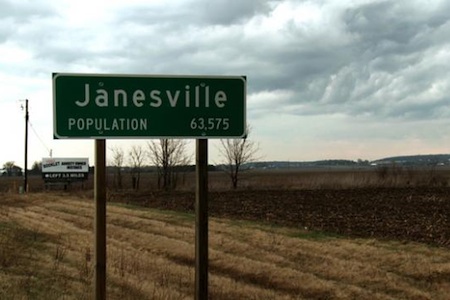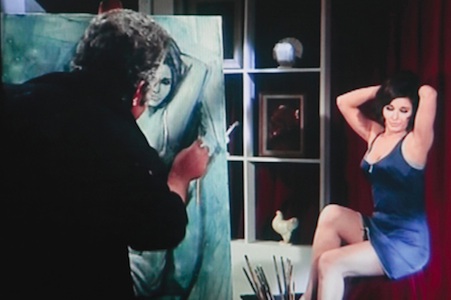Despite its standing as the oldest competitive film festival in North America, the Chicago International Film Festival has suffered from “Second City” syndrome, struggling to become a destination festival for filmmakers and audiences alike. As the economy continues to gasp, and noting the popularity of such homegrown productions of years past as Chicago Overcoat and The Last Rites of Joe May, programmers hit on the idea of emphasizing native sons and daughters to attract locals. “The Chicagoans” celebrity conversations include evenings with actress Joan Allen and documentarian Steve James, word jazz artist and voice of the CIFF Ken Nordine, and director/screenwriter Philip Kaufman, as well as a healthy complement of local filmmakers in the City and State series.
Allen, who received a Silver Hugo for Career Achievement from festival founder Michael Kutza, offered a warm précis of her career, including her early years as a member of Chicago’s Steppenwolf Theatre Company, which she and a number of other members—most prominently, John Malkovich and Gary Sinise—have largely abandoned as their stars have risen. She singled out Michael Mann, with whom she worked on Manhunter (1986), as a driven taskmaster whose work fills her with nothing but admiration. While Allen took no audience questions, a throng of adoring fans were able to meet and speak with her briefly in a photo session and poster signing after the presentation.
Kaufman, certainly one of the more interesting native sons to go West, recently came back into public consciousness by directing this year’s acclaimed HBO miniseries Hemingway and Gellhorn. His conversation with his critical biographer Annette Insdorf was preceded by a showing of the 1974 feature film The White Dawn, a compelling look at the cultural tensions between three shipwrecked whalers rescued from the wilds of Baffin Island, Canada, by a small Inuit community at the end of the 19th century. Heartbreakingly, Kaufman shared that the color saturation was much richer as shot by his DP Michael Chapman (Taxi Driver, Raging Bull), but that the DVD version of the film is all that is left for viewing, emphasizing that our lost film heritage extends well beyond the silent era. He also related that The White Dawn was slated to go to Cannes, but after some lobbying by Francis Ford Coppola, The Conversation ended up being the pick for the French festival, where it won the Palme d’Or. By contrast, The White Dawn is little known today.
Of course, hardcore cinephiles in the Chicago area are mainly interested in viewing the “big” films from other international festivals. The CIFF complied by booking Abbas Kiarostami’s Like Someone in Love, Paolo and Vittorio Taviani’s Caesar Must Die, Cristian Mungiu’s Beyond the Hills, and Michel Franco’s After Lucia. Olivier Assayas’ Something in the Air is certainly of a piece with his well-regarded memory drama Summer Hours (2008), recounting in semi-autobiographical fashion the coming-of-age stories of several high school students involved in the 1971 uprisings in France. With the sun-dappled meadow look that has become an Assayas trademark, Something in the Air is episodic and slightly smug, but still worth seeing for the compelling performance of its lead actor Clément Métayer. Finally, Leos Carax’s much-anticipated, must-see film of the year, Holy Motors, blasts onto the screen with an antic energy, as brilliant lead actor Denis Lavant creates more than nine characters for increasingly strange “appointments.” Carax hasn’t released a feature film for a long time—13 years—but as one of Lavant’s creations says, he was never gone; this film testifies to the health of Carax’s fertile imagination and exquisite filmmaking technique.
Unsurprisingly, master documentarian Steve James’ Kartemquin Films-co-produced As Goes Janesville (directed by Brad Lichtenstein) has been earning praise for its eyes-wide-open look at the economic devastation afoot in the land by focusing on a GM plant closing in Janesville, Wisconsin, and the stratified political climate in Wisconsin, which saw Gov. Scott Walker barely stave off being recalled in a special election this year. A personal favorite is The Three Disappearances of Soad Hosni. Conceived by Lebanese video artist Rania Stephan as a tribute to Egyptian actress Soad Hosni, who was a huge star in the Arab world from her debut in 1959 through the mid 1990s, the film functions on an archetypal level, using nothing but clips from videotapes of Hosni’s films arranged to tell the actress’ story from her childhood, through her early ambitions, her loves, her marriages and through to her heartbreaks and death—a story that could apply to almost any woman.
Equally compelling, even at 185 minutes, is Anand Patwardhan’s complex documentary Jai Bhim Comrade. Fourteen years in the making, Patwardhan chronicles the struggles of the untouchable caste in India, who prefer to call themselves Dalits (The Oppressed), to assert the equality guaranteed to them in the Indian constitution cowritten by a revered Dalit Bhimrao Ramji Ambedkar. Contrasting this tragic, ongoing problem was a showing immediately after of Numbered, an Israeli film that rounded up some of the last survivors of Auschwitz to photograph the numbers the Nazis tattooed on their arms. Certainly, the featured survivors were pleasant and interesting, and the still photos taken by codirector Uriel Sinai were gorgeous (maybe too gorgeous), but unless you’ve never seen a Holocaust film before—a seeming impossibility in this day and age—there’s nothing new to glean from this feel-good homage.
The festival seems to be letting go of its overreliance on French films, and the growing number of feature and documentary offerings from Africa and Asia is a welcome trend. Among the best of these films is Tey, a Senegalese fable of a day in the life of one young man who knows he is going to die when he goes to sleep at night. Director Alain Gomis told the audience after the screening that the “last day” story is found in cultures throughout the world, and that he wanted to contemplate its meaning for the present time. He cast American actor Saul Williams in the central role for his talent, his Senegalese looks, and the alienating effect he would project by not knowing the languages of the actors working with him. The result is hauntingly beautiful and contemplative.
Not yet seen but anticipated are the Indonesian film Postcards from the Zoo and Raul Ruiz’s last completed film Night across the Street. Best of the Fest screenings take place October 24, and the Closing Night features Robert Zemeckis’s new thriller Flight, starring Denzel Washington.
Marilyn Ferdinand is a Keyframe contributor and proprietor of the film review blog, Ferdy on Films. She is a member of the Online Film Critics Society.






